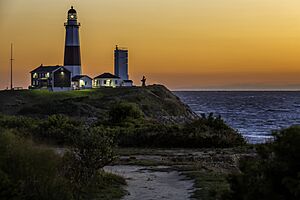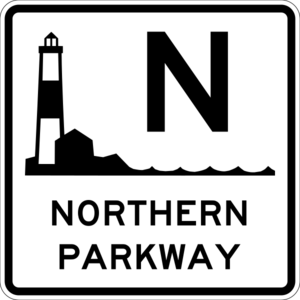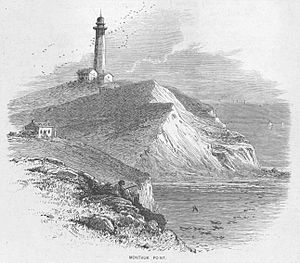Montauk Point Light facts for kids
| Location | Montauk Point, Suffolk County, New York, U.S. |
|---|---|
| Coordinates | 41°04′16″N 71°51′26″W / 41.07099°N 71.85709°W |
| Year first lit | 1797 |
| Automated | 1987 |
| Foundation | 13 ft (4 m) deep and 9 ft (3 m) thick, Natural, Emplaced, built in 1796 |
| Construction | Sandstone |
| Tower shape | Octagonal pyramidal |
| Markings / pattern | Tower painted white with a broad red band midway, lantern black |
| Height | 110.5 ft (33.7 m) structure |
| Focal height | 168 ft (51 m) |
| Original lens | 8 whale oil lamps (1797), Fresnel lens (later) 1903-1987, VRB-25 1987-2023, as of 11/06/2023 the same (reconditioned) 3 1/2 order bivalve Fresnel lens that was removed in 1987. (current) |
| Range | 18 nm |
| Characteristic | Flashing White 5 seconds. |
| Fog signal | Horn: 1 2s in every 15s |
The Montauk Point Lighthouse is a famous lighthouse. It stands at the very eastern tip of Long Island in Montauk, New York, right next to Montauk Point State Park. It was the first lighthouse ever built in New York State. It's also the fourth oldest lighthouse still working in the entire United States!
The Montauk Point Lighthouse is so important that it's listed on the National Register of Historic Places. In 2012, it was named a National Historic Landmark. This means it's a very special place in American history. It helped guide ships for many years, especially during the early days of the United States.
The lighthouse is on Turtle Hill, at 2000 Montauk Highway. It's a museum run by a private group, not part of the state park.

Contents
The Lighthouse's Story


The Montauk Point Lighthouse was the first lighthouse built in New York State. It is also the fourth oldest lighthouse still active in the United States. The tower stands about 110 feet (33.7 meters) tall. Today, it uses a special type of light called a 3½ order bivalve Fresnel lens.
Building the Lighthouse
The idea to build the lighthouse was approved on April 12, 1792. This happened under President George Washington. Ezra L'Hommedieu, a lawyer and scientist, helped Washington plan the lighthouse. He worked with the New York City Chamber of Commerce.
L'Hommedieu explained that New York City was a very busy port. By 1797, it handled a third of all trade with other countries. Ships coming from the sea needed a lighthouse at the end of Long Island. This would guide them safely into New York Harbor, especially in winter.
L'Hommedieu chose the perfect spot for the lighthouse and designed it. Construction started on June 7, 1796. It was finished on November 5, 1796. This was one of the very first public projects of the new United States of America. In April 1797, the first keeper, Jacob Hand, lit the lamps. The lighthouse began guiding ships. It was run by civilian keepers until World War II.
Changes Over Time
In 1860, the lighthouse got a big upgrade. Two new levels and a larger lantern were added. This made the tower taller, from 80 feet to its current 110 feet. A huge Fresnel lens was put in. It was 12 feet tall and weighed about 10,000 pounds! The keeper's house was also built then.
In 1873, a steam-powered fog signal was added. A building for it was built in 1897. The tower was originally all white. The single brown stripe you see today was added in 1899.
A smaller red light was added in 1903. It warned ships about Shagwong Reef, a dangerous spot. This light was damaged in a big hurricane in 1938. It was removed in 1940 when the lighthouse got electricity. The huge Fresnel lens was replaced in 1903 with a smaller, but still powerful, 3½ order bivalve Fresnel lens. This lens was used until 1987.
On November 6, 2023, the original 3½ order bivalve Fresnel lens was put back in the lighthouse. It had been restored and now shines again.
The Lighthouse During World War II
During World War II, the U.S. Army took over the lighthouse. It became part of the Eastern Coastal Defense Shield. The last civilian keepers left in 1943.
Next to the lighthouse, the Army built Camp Hero in 1942. It had large guns to protect the coast. You can still see the concrete gun placements and fire control towers today.
Transfer to the Montauk Historical Society
In 1946, the United States Coast Guard took care of the lighthouse. It became automated on February 3, 1987. This meant it no longer needed keepers to operate it.
In May 1987, the lighthouse museum opened to the public. The Montauk Historical Society ran it. On September 30, 1996, President Bill Clinton signed a law. This officially gave the lighthouse property to the Montauk Historical Society.
Protecting the Lighthouse from Erosion
The lighthouse was built 300 feet (91 meters) from the cliff edge. But over time, the land eroded, and it got closer to the edge. After World War II, the United States Army Corps of Engineers built a seawall. But the erosion continued.
In 1967, the Coast Guard thought about tearing down the lighthouse. They wanted to build a new steel tower farther back. People protested this idea. Congressman Michael Forbes helped pass a bill. This bill gave the lighthouse to the Montauk Historical Society to save it.
Giorgina Reid, a textile designer, had saved her own cottage from erosion. She suggested a similar solution for the lighthouse. Her idea was to build terraces using natural materials like reeds. This method helped stop the erosion. Greg Donohue, a landscaper, continued her work after she retired. With help from many groups, the erosion control project finished in 1998.
However, erosion continued to be a problem. In 2006, the United States Army Corps of Engineers planned to build another seawall. But a local surfing group disagreed. They said a seawall would ruin a famous surf spot nearby. They suggested moving the lighthouse instead, like the Cape Hatteras Lighthouse. Moving it would be difficult because of the hilly land. Environmental groups also worried that stopping erosion here might cause more erosion on other Long Island beaches.
On March 2, 2012, the lighthouse was officially named a National Historic Landmark. It was the 14th site on Long Island and the 11th lighthouse in the country to get this honor.
Legend says that Pirate Captain Kidd buried treasure near the lighthouse around 1699. He supposedly hid it at two ponds, which are now called "Money Ponds."
Recent Renovations
On January 13, 2020, the United States Army Corps of Engineers announced a big project. They awarded a $30.7 million contract to protect the lighthouse from erosion. Work started in 2021 and finished in August 2023.
The project involved building a strong stone wall about 1,000 feet long. They used existing stones and added new, heavier ones. They also stabilized the slope above the wall with terraces and plants. The lighthouse itself was completely repainted. The total cost for this important project was $44 million.
Images for kids
-
Montauk Point Lighthouse, on a NOAA nautical chart







